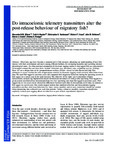Do intracoelomic telemetry transmitters alter the post‐release behaviour of migratory fish?
| dc.contributor.author | Wilson, Alexander | |
| dc.contributor.author | Hayden, TA | |
| dc.contributor.author | Vandergoot, CS | |
| dc.contributor.author | Kraus, RT | |
| dc.contributor.author | Dettmers, JM | |
| dc.contributor.author | Cooke, SJ | |
| dc.contributor.author | Krueger, CC | |
| dc.date.accessioned | 2018-05-09T08:58:44Z | |
| dc.date.available | 2018-05-09T08:58:44Z | |
| dc.date.issued | 2017-04 | |
| dc.identifier.issn | 0906-6691 | |
| dc.identifier.issn | 1600-0633 | |
| dc.identifier.uri | http://hdl.handle.net/10026.1/11422 | |
| dc.description.abstract |
<jats:title>Abstract</jats:title><jats:p>Electronic tags have become a common tool in fish research, enhancing our understanding of how fish interact with their environment and move among different habitats, for estimating mortality and recording internal physiological states. An often‐untested assumption of electronic tagging studies is that tagged fish are representative of untagged conspecifics and thus show ‘normal’ behaviour (e.g. movement rates, swimming activity, feeding). Here, we use a unique data set for potamadromous walleye (<jats:italic>Sander vitreus</jats:italic>) in Lake Huron and Lake Erie tributaries to assess whether the lack of appropriate controls in electronic tagging could seriously affect behavioural data. We used fish tagged in previous years and compared their migratory behaviour during the spawning season to fish tagged in a current year at the same location. The objective of the study was to determine whether intracoelomic acoustic tag implantation altered downstream movement of walleye after spawning. Fish tagged in a given season travelled slower downstream from two river spawning sites than fish tagged in previous years. Fish tagged one or two years earlier showed no differences between each other in downstream travel time, in contrast to fish tagged in a given year. Our results support notions that standard collection and intracoelomic tagging procedures can alter short‐term behaviour (i.e. days, weeks, months), and as such, researchers should use caution when interpreting data collected over such time periods. Further, whenever possible, researchers should also explicitly evaluate post‐tagging effects on behaviour as part of their experimental objectives.</jats:p> | |
| dc.format.extent | 292-300 | |
| dc.language | en | |
| dc.language.iso | en | |
| dc.publisher | Wiley | |
| dc.subject | fish tagging | |
| dc.subject | transmitter implantation | |
| dc.subject | tagging effects | |
| dc.subject | behaviour | |
| dc.subject | surgery | |
| dc.title | Do intracoelomic telemetry transmitters alter the post‐release behaviour of migratory fish? | |
| dc.type | journal-article | |
| dc.type | Journal Article | |
| plymouth.author-url | https://www.webofscience.com/api/gateway?GWVersion=2&SrcApp=PARTNER_APP&SrcAuth=LinksAMR&KeyUT=WOS:000395645400011&DestLinkType=FullRecord&DestApp=ALL_WOS&UsrCustomerID=11bb513d99f797142bcfeffcc58ea008 | |
| plymouth.issue | 2 | |
| plymouth.volume | 26 | |
| plymouth.publication-status | Published | |
| plymouth.journal | Ecology of Freshwater Fish | |
| dc.identifier.doi | 10.1111/eff.12275 | |
| plymouth.organisational-group | /Plymouth | |
| plymouth.organisational-group | /Plymouth/Faculty of Science and Engineering | |
| plymouth.organisational-group | /Plymouth/Faculty of Science and Engineering/School of Biological and Marine Sciences | |
| plymouth.organisational-group | /Plymouth/REF 2021 Researchers by UoA | |
| plymouth.organisational-group | /Plymouth/REF 2021 Researchers by UoA/UoA07 Earth Systems and Environmental Sciences | |
| plymouth.organisational-group | /Plymouth/Users by role | |
| plymouth.organisational-group | /Plymouth/Users by role/Academics | |
| dc.identifier.eissn | 1600-0633 | |
| dc.rights.embargoperiod | No embargo | |
| rioxxterms.versionofrecord | 10.1111/eff.12275 | |
| rioxxterms.licenseref.uri | http://www.rioxx.net/licenses/all-rights-reserved | |
| rioxxterms.type | Journal Article/Review |


